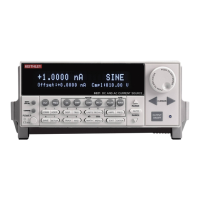Model 6220/6221 User’s Manual Delta, Pulse Delta, and Differential Conductance 5-29
Return to Section 5 topics
Operation
Pulse Delta operation – front panel
The system configuration for front panel stand-alone operation is shown in
Figure 5-2A on page 5-5.
1. Connections are shown in the following illustrations. All power must be
removed from all components in the system before making connections:
• Figure 5-3, page 5-6 – System connections
• Figure 5-5, page 5-8 – DUT test connections
2. Configure communications for the Models 2182A and 6221 as explained in
“Configuring communications” on page 5-9.
3. On the Model 2182A, select the desired measurement range (using the
RANGE keys).
4. Perform one the following steps to configure Pulse Delta: Step I for Fixed
output, or Step II for Sweep output. “Configuration settings” are explained
on page 5-26.
I. Fixed output – On the Model 6221, press CONFIG and then PULSE to
access the CONFIG PULSE DELTA menu.
a. Set I-HI, I-LO, pulse WIDTH, COUNT, RANGING, source delay (SRC
DEL), INTERVAL, disable (NO) the SWEEP function, and set the num-
ber of low measurements (LOW MEAS) to perform.
b. When finished configuring the Fixed output, use the EXIT key to back
out of the menu structure.
II. Sweep output – Two configure processes are required for Sweep output:
a. On the Model 6221, press CONFIG and then PULSE to access the
CONFIG PULSE DELTA menu. Use this menu to set pulse WIDTH,
COUNT, set the number of low measurements (LOW MEAS) to per-
form, and enable (YES) the SWEEP function. When finished, use the
EXIT key to return to the normal display state.
b. On the Model 6221, press CONFIG and then SWP to access the
CONFIGURE SWEEPS menu. Use the TYPE menu item to select and
configure the sweep (including the sweep delay), and use the
SOURCE RANGING menu item to select ranging (BEST, FIXED, or
AUTO). When finished, use the EXIT key to return to the normal dis-
play state.
5. Set the measurement units.
The basic Pulse Delta reading is in volts (which is the default units setting).
However, it can instead be expressed (and displayed) as an Ohms, Watts,
or Siemens reading. With Watts as the selected units, the reading can be a
Peak power reading or an Average power reading. See “Measurement
units” on page 5-11 for details.

